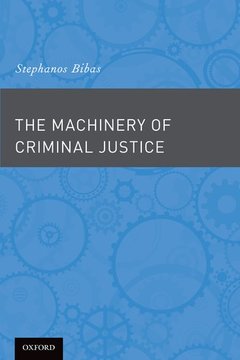The Machinery of Criminal Justice
Langue : Anglais
Auteur : Bibas Stephanos

Two centuries ago, the American criminal justice was run primarily by laymen. Jury trials passed moral judgment on crimes, vindicated victims and innocent defendants, and denounced the guilty. But over the last two centuries, lawyers have taken over the process, silencing victims and defendants and, in many cases, substituting a plea-bargaining system for the voice of the jury. The public sees little of how this assembly-line justice works, and victims and defendants have largely lost their day in court. As a result, victims rarely hear defendants express remorse and apologize, and defendants rarely receive forgiveness. This lawyerized machinery has purchased efficient, speedy processing of many cases at the price of sacrificing softer values, such as reforming defendants and healing wounded victims and relationships. In other words, the U.S. legal system has bought quantity at the price of quality, without recognizing either the trade-off or the great gulf separating lawyers' and laymen's incentives, interests, values, and powers. In The Machinery of Criminal Justice, author Stephanos Bibas surveys these developments over the last two centuries, considers what we have lost in our quest for efficient punishment, and suggests ways to include victims, defendants, and the public once again. These ideas range from requiring convicts to work or serve in the military, to moving power from prosecutors to restorative sentencing juries. Bibas argues that doing so might cost more, but it would better serve criminal procedure's interests in denouncing crime, vindicating victims, reforming wrongdoers, and healing the relationships torn by crime.
Author Biography. Acknowledgements. Introduction: The Divergence of Theory, Reality, and Morality. Overview of the Book. Themes of the Book. Chapter I: The Long Drift from Morality Play to Assembly Line. A. Criminal Justice in the Early American Colonies. 1. Small-Town Morality. 2. Lay Justice. 3. Room for Mercy. 4. Reintegrative Punishment. B. Criminal Justice Since the American Revolution. 1. The Changing Aims of Criminal Justice. 2. Professionalization. 3. The Birth of Plea Bargaining. 4. The Hiding of Punishment Behind Prison Walls. 5. The Decline of Mercy. Chapter II: Opaque, Unresponsive Criminal Justice. A. The Players. 1. Dominant Insiders, Savvy and Self-Interested. 2. Excluded Outsiders, Yearning for Justice. B. The Play of the Game. 1. Round One: Insiders' Procedural Discretion Shapes the Rules in Action. 2. Round Two: Outsiders Try to Check Insiders. 3. Round Three: Insiders' Procedural Discretion Undercuts Reforms. 4. Round Four: Outsiders, Egged on by Politicians, Take Matters into Their Own Hands. 5. Round Five: Insiders Circumvent Even alt,"Mandatoryagt," Reforms. C. Costs of the Game. 1. Clouding the Criminal Law's Substantive Message and Effectiveness. 2. Undermining Legitimacy and Trust. 3. Hindering Public Monitoring and Preferences. D. Defense Lawyers and Defendants' Distrust. 1. Insider Defense Counsel's Interests and Pressures. 2. Defendants' Overoptimism and Risk-Taking. 3. Miscommunication, Mistrust, and Timing. Chapter III: Denial, Remorse, Apology, and Forgiveness. A. Denial and Equivocation. 1. The Use of Pleas by Defendants in Denial. 2. The Danger of Convicting the Innocent. 3. The Costs of False Denial and the Value of Confession. 4. The Value of Trials as Morality Plays. B. Remorse, Apology, and Forgiveness. 1. The Irrelevance of Remorse and Apology in Contemporary Criminal Justice. 2. Crime as a Relational Concept. 3. Lessons from Noncriminal Contexts: Civil Mediation. Chapter IV: Whose Voices Belong in Criminal Justice?. A. The State's Monopoly on Criminal Justice. B. Incomplete Alternatives to the State's Assembly Line. 1. Victims' Rights. 2. Restorative Justice. 3. Therapeutic Jurisprudence and Problem-Solving Courts. Chapter V: Popular Moral Discourse Versus Assembly-Line Efficiency. A. Efficiency Instead of Moral Judgment. B. Why Not Address Substantive Moral Goals?. Chapter VI: Returning Power to the Public in a Lawyer-Driven System. A. Macro-Level Reforms. 1. From Idle Imprisonment to Work, Accountability, and Reform. 2. Collateral Consequences and Reentry. B. Mid-Level Reforms to Include the Public. 1. Greater Transparency. 2. Increasing Public Participation. C. Micro-Level Solutions. 1. Victim Information and Consultation. 2. Defendants' Information and Participation. 3. Restorative Sentencing Juries.
Stephanos Bibas is a professor at the University of Pennsylvania Law School, where he specializes in criminal procedure. As director of Penn's Supreme Court Clinic, he also litigates a wide array of cases before the Supreme Court of the United States. After graduating from Yale Law School and clerking at the Supreme Court, he worked as a federal prosecutor in New York City, where he prosecuted a wide array of criminal cases. He successfully investigated, prosecuted, and convicted the world's leading expert in Tiffany stained glass for hiring a grave robber to loot priceless Tiffany windows from tombs in cemeteries, winning an FBI award for outstanding performance. He has published widely on plea bargaining, sentencing, and how criminal procedure could better serve the substantive moral goals of the criminal law.
Date de parution : 03-2015
Ouvrage de 320 p.
23.1x15.2 cm
Date de parution : 04-2012
Ouvrage de 320 p.
23.4x15.5 cm
Thème de The Machinery of Criminal Justice :
© 2024 LAVOISIER S.A.S.



